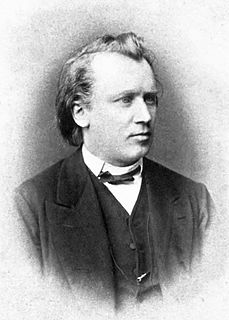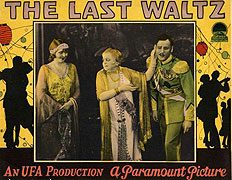See also
| This page lists people with the surname Waltzer. If an internal link intending to refer to a specific person led you to this page, you may wish to change that link by adding the person's given name(s) to the link. |
Waltzer is a surname. It may refer to:
| This page lists people with the surname Waltzer. If an internal link intending to refer to a specific person led you to this page, you may wish to change that link by adding the person's given name(s) to the link. |

Johann Strauss II, also known as Johann Strauss Jr., the Younger, the Son, was an Austrian composer of light music, particularly dance music and operettas. He composed over 500 waltzes, polkas, quadrilles, and other types of dance music, as well as several operettas and a ballet. In his lifetime, he was known as "The Waltz King", and was largely responsible for the popularity of the waltz in Vienna during the 19th century. Some of Johann Strauss's most famous works include "The Blue Danube", "Kaiser-Walzer", "Tales from the Vienna Woods", and the "Tritsch-Tratsch-Polka". Among his operettas, Die Fledermaus and Der Zigeunerbaron are the best known.

Johann Strauss I was an Austrian Romantic composer. He was famous for his waltzes, and he popularized them alongside Joseph Lanner, thereby setting the foundations for his sons to carry on his musical dynasty. He is best known for his composition of the Radetzky March.

Viennese waltz is a genre of ballroom dance. At least four different meanings are recognized. In the historically first sense, the name may refer to several versions of the waltz, including the earliest waltzes done in ballroom dancing, danced to the music of Viennese waltz.

Alfred Grünwald was an Austrian author, librettist, and lyricist. Some of his better-known works were written in conjunction with the composers Franz Lehár, Emmerich Kálmán, Oscar Straus, Paul Abraham, and Robert Stolz.

Johann Strauss III was an Austrian composer whose father was Eduard Strauss, whose uncles were Johann Strauss II and Josef Strauss, and whose grandfather was Johann Strauss I. He was unofficially entrusted with the task of upholding his family's tradition after the dissolution of the Strauss Orchestra by his father in 1901. His talents were not fully realized during his lifetime as musical tastes had changed in the Silver Age with more popular composers such as Franz Lehár and Oscar Straus dominating the Viennese musical scene with their operettas, although his uncle, Johann Strauss II, supervised his development as a musician, a fact disputed by Eduard Strauss.

Joseph Lanner was an Austrian dance music composer and dance orchestra conductor. He is best remembered as one of the earliest Viennese composers to reform the waltz from a simple peasant dance to something that even the highest society could enjoy, either as an accompaniment to the dance, or for the music's own sake. He was just as famous as his friend and musical rival Johann Strauss I, who was better known outside of Austria in their day because of his concert tours abroad, in particular, to France and England.
Cagliostro-Walzer op.370 is a waltz by Johann Strauss II composed in 1875 based on themes from his operetta, Cagliostro in Wien which premiered on 27 February 1875 at the famous Theater an der Wien.

Kaiser-Walzer, Op. 437 is a waltz composed by Johann Strauss II in 1889. The waltz was originally titled Hand in Hand and was intended as a toast made in August of that year by Emperor of Austria Franz Joseph I on the occasion of his visit to the German Emperor Wilhelm II where it was symbolic as a 'toast of friendship' extended by Austria-Hungary to the German Empire.
The Walser are descendants of people who migrated from the Wallis, Switzerland, to other Alpine regions. The Highest Alemannic Walser German dialects are still very similar to Walliser German
The term Schatz can refer to:

Sixteen Waltzes, Op. 39, is a set of 16 short waltzes for piano written by Johannes Brahms. They were composed in 1865, and published in 1866, dedicated to the music critic Eduard Hanslick.
Walzer aus Wien is a singspiel pasticcio in three acts, libretto by Alfred Maria Willner, Heinz Reichert and Ernst Marischka, music by Johann Strauss II (son), arranged by Erich Wolfgang Korngold and Julius Bittner, first performed at the Stadttheater in Vienna on 30 October 1930. An English musical theatre adaptation called The Great Waltz played on Broadway in 1934, and another English version played in London in 1970.
Liebeslieder Walzer is a two-part neoclassical ballet choreographed by George Balanchine to Johannes Brahms' Liebeslieder Waltzes, Op. 52 and Neue Liebeslieder, Op. 65, with original sets and lighting designed by David Hays, and costumes designed by Barbara Karinska. The ballet premiered on 12 November 1960 at the New York City Center, performed by the New York City Ballet.
Walzer may refer to:

"Gartenlaube Waltz", Op. 461, German: "Gartenlaube-Walzer" is the title of a waltz by the Austrian composer Johann Strauss II. The waltz was dedicated to readers of the magazine Die Gartenlaube, a German weekly for the middle class, which became the most-read magazine in 1890s Germany.

The Last Waltz is a 1927 German silent romance film directed by Arthur Robison and starring Liane Haid, Willy Fritsch and Suzy Vernon. It was based on the 1920 operetta Der letzte Walzer by Oscar Straus.

Johannes Brahms' Liebeslieder Waltzes (Liebeslieder-Walzer) are distributed across two opus numbers: Op. 52 and Op. 65. The waltzes are a collection of love songs in Ländler style for voices and piano four hands. The lyrics for the Liebeslieder come from Georg Friedrich Daumer's Polydora, a collection of folk songs and love poems. While there is no concrete record indicating the exact inspiration for the Waltzes, there is speculation that Brahms' motivation for the songs was his frustrated love for pianist and composer Clara Schumann.
Wälzer is a surname. It may refer to:
Walzer is a German surname. It may refer to: